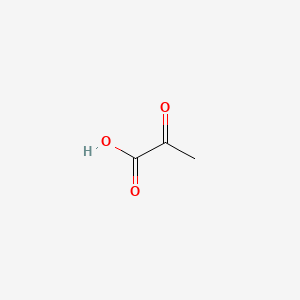

1. Acid, Pyruvic
2. Pyruvate
1. 2-oxopropanoic Acid
2. 127-17-3
3. Acetylformic Acid
4. Pyroracemic Acid
5. 2-oxopropionic Acid
6. Alpha-ketopropionic Acid
7. 2-ketopropionic Acid
8. Propanoic Acid, 2-oxo-
9. 2-oxopropanoate
10. 2-oxo-propionic Acid
11. 2-oxopropansaeure
12. 2-oxopropionsaeure
13. Alpha-oxopropionsaeure
14. Pyruvic Acid (natural)
15. Acide Pyruvique
16. A-ketopropionic Acid
17. Propanoic Acid, Oxo-
18. Ch3cocooh
19. Fema No. 2970
20. Alpha-keto Propionic Acid
21. Nsc 179
22. .alpha.-ketopropionic Acid
23. 2-ketopropanoic Acid
24. Ai3-11220
25. 8558g7rutr
26. Chebi:32816
27. Nsc-179
28. Dsstox_cid_1650
29. 2-oxo-propanoic Acid
30. Dsstox_rid_76263
31. Dsstox_gsid_21650
32. Pyruvicacid
33. Brenztraubensaeure
34. Cas-127-17-3
35. Pyruvic Acid (8ci)
36. Einecs 204-824-3
37. Brn 0506211
38. Unii-8558g7rutr
39. Acetylformate
40. Pyroracemate
41. A-ketopropionate
42. 2-oxopropionate
43. Acetyl Formic Acid
44. 2-oxopropanoicacid
45. Alpha-ketopropionate
46. 2-oxopropanoic'acid
47. Mfcd00002585
48. Nchembio867-comp8
49. 2-oxo Propanoic Acid
50. Pyruvic Acid, 95%
51. Pyruvic Acid, 98%
52. 4b5s
53. Bmse000112
54. Pyruvic Acid [mi]
55. Pyruvic-2-[13c] Acid
56. P-9250
57. Nciopen2_000039
58. Pyruvic Acid [fhfi]
59. Pyruvic Acid [inci]
60. 4-03-00-01505 (beilstein Handbook Reference)
61. Pyruvic Acid, P.a., 98%
62. Pyruvic Acid [who-dd]
63. Pyruvic Acid, >=97%, Fg
64. Gtpl4809
65. Nsc179
66. Chembl1162144
67. Dtxsid2021650
68. Bdbm19473
69. Pyruvic Acid, Natural, >=80%
70. Amy6082
71. Propanoic Acid, 2-oxo- (9ci)
72. Hy-y0781
73. Zinc1532517
74. Tox21_202096
75. Tox21_303284
76. Bbl027390
77. Lmfa01060077
78. S3143
79. 2-oxopropanoic Acid, Pyroracemic Acid
80. Akos000118803
81. Cs-w020190
82. Db00119
83. Ncgc00165990-01
84. Ncgc00165990-02
85. Ncgc00257000-01
86. Ncgc00259645-01
87. Pyruvic Acid, Technical, >=95.0% (t)
88. Ft-0612738
89. P0579
90. C00022
91. Q213580
92. B3cff0ad-2f35-484c-b062-4ac88a1b2830
93. F2191-0254
94. Z1741977082
95. Pyruvic Acid, United States Pharmacopeia (usp) Reference Standard
| Molecular Weight | 88.06 g/mol |
|---|---|
| Molecular Formula | C3H4O3 |
| XLogP3 | -0.3 |
| Hydrogen Bond Donor Count | 1 |
| Hydrogen Bond Acceptor Count | 3 |
| Rotatable Bond Count | 1 |
| Exact Mass | 88.016043985 g/mol |
| Monoisotopic Mass | 88.016043985 g/mol |
| Topological Polar Surface Area | 54.4 Ų |
| Heavy Atom Count | 6 |
| Formal Charge | 0 |
| Complexity | 84 |
| Isotope Atom Count | 0 |
| Defined Atom Stereocenter Count | 0 |
| Undefined Atom Stereocenter Count | 0 |
| Defined Bond Stereocenter Count | 0 |
| Undefined Bond Stereocenter Count | 0 |
| Covalently Bonded Unit Count | 1 |
For nutritional supplementation, also for treating dietary shortage or imbalance
Pyruvic acid or pyruvate is a key intermediate in the glycolytic and pyruvate dehydrogenase pathways, which are involved in biological energy production. Pyruvate is widely found in living organisms. It is not an essential nutrient since it can be synthesized in the cells of the body. Certain fruits and vegetables are rich in pyruvate. For example, an average-size red apple contains approximately 450 milligrams. Dark beer and red wine are also rich sources of pyruvate. Recent research suggests that pyruvate in high concentrations may have a role in cardiovascular therapy, as an inotropic agent. Supplements of this dietary substance may also have bariatric and ergogenic applications.
Absorption
Pyruvate is absorbed from the gastrointestinal tract from whence it is transported to the liver via the portal circulation.
In the liver, pyruvate is metabolized via several pathways.
Pyruvate serves as a biological fuel by being converted to acetyl coenzyme A, which enters the tricarboxylic acid or Krebs cycle where it is metabolized to produce ATP aerobically. Energy can also be obtained anaerobically from pyruvate via its conversion to lactate. Pyruvate injections or perfusions increase contractile function of hearts when metabolizing glucose or fatty acids. This inotropic effect is striking in hearts stunned by ischemia/reperfusion. The inotropic effect of pyruvate requires intracoronary infusion. Among possible mechanisms for this effect are increased generation of ATP and an increase in ATP phosphorylation potential. Another is activation of pyruvate dehydrogenase, promoting its own oxidation by inhibiting pyruvate dehydrogenase kinase. Pyruvate dehydrogenase is inactivated in ischemia myocardium. Yet another is reduction of cytosolic inorganic phosphate concentration. Pyruvate, as an antioxidant, is known to scavenge such reactive oxygen species as hydrogen peroxide and lipid peroxides. Indirectly, supraphysiological levels of pyruvate may increase cellular reduced glutathione.
BUILDING BLOCK

